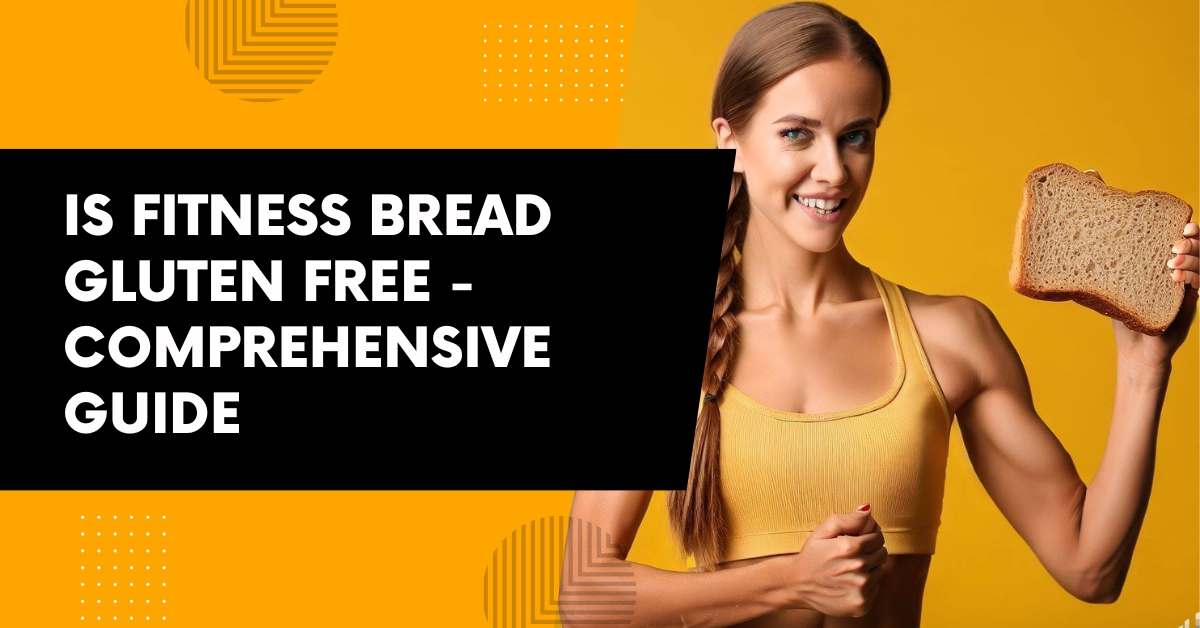Discover the secret is fitness bread gluten free indulgence with our fitness bread. Uncover whether it’s gluten-free and embark on a healthier journey today.
Introduction
The quest for nutritional and diet-friendly options has become increasingly important in a world where health-conscious choices reign supreme. Fitness bread, for example, has gained considerable attention in recent years. We are striving to make smarter food choices, but the question remains: Is fitness bread gluten-free? We will explore the answer to this question and explore the implications for a healthy lifestyle as we journey through fitness bread. In this exploration, we will delve into the essence of fitness bread, dissect its ingredients, and determine if it aligns with the gluten-free criteria that many seek in their dietary choices. We will embark on an exciting journey into the world of fitness bread and gluten-free recipes.
Understanding Gluten
There is a term that frequently takes center stage when discussing diet and nutrition. A protein found in several grains, gluten plays a crucial role in many of our favorite foods. But what exactly is gluten, and why does it evoke such concern and attention? To gain a better understanding of this fascinating component of our diets, let’s dive into the world of gluten.
1. What is Gluten?
A protein composite known as gluten is naturally found in certain grains, primarily wheat, barley, and rye. Gluten is essential in a wide range of foods, from bread and pasta to cakes and pastries, because of its unique properties. It is the reason dough rises and maintains its shape during baking.
2. The Gluten Controversy
The use of gluten in many culinary delights has led to controversy in recent years. Some people cannot tolerate gluten due to medical conditions such as celiac disease, wheat allergy, or non-celiac gluten sensitivity. It is possible for these individuals to suffer from adverse health effects as a result of gluten consumption, ranging from digestive issues to skin problems and fatigue.
3. Celiac Disease
Individuals with celiac disease are susceptible to developing an autoimmune disorder caused by gluten ingestion. Upon consuming gluten, the immune system mounts an attack on the lining of the small intestine, resulting in a number of symptoms as well as long-term health complications.
4. Wheat Allergy
The result of a wheat allergy is an allergic reaction to proteins found in wheat, including but not limited to gluten. Symptoms of a wheat allergy can range from mild hives to severe anaphylaxis and food containing wheat must be avoided strictly.
5. Non-Celiac Gluten Sensitivity
Gluten sensitivity non-celiac occurs when individuals experience symptoms similar to those associated with celiac disease when they consume gluten, but without the autoimmune response that is associated with celiac disease. Although this condition remains poorly understood, its impact on those affected is undeniable.
6. Gluten-Free Diets
The popularity of gluten-free diets has increased as a result of the challenges faced by individuals suffering from gluten-related disorders. These diets exclude all sources of gluten, thus providing relief and improving health.
The Bottom Line
As a fundamental component of many foods, gluten can be problematic for individuals with specific health conditions. Understanding gluten is essential to making informed dietary choices. You can contribute to your health and well-being by keeping gluten in mind as you navigate the world of nutrition, and choosing gluten-free options when necessary.
Delving into the complexities of gluten is a valuable step on your journey towards a healthier lifestyle, regardless of whether you are exploring gluten-free alternatives or simply seeking to broaden your nutritional knowledge.
Is fitness bread gluten free

1. What is fitness bread?
Designed for health-conscious consumers, fitness bread is more than just a loaf of bread; it’s a powerhouse of nutrition. For those looking to maintain a healthy diet while indulging in their favorite sandwiches or toast, fitness bread is a great choice. It is packed with whole grains, and seeds, and is often free from artificial additives.
Fitness bread contains a variety of ingredients, including sunflower seeds, flax seeds, whole grains, oats, and more. These components provide fiber, healthy fats, and essential nutrients.
2. Fitness bread gluten-free
What does fitness bread have to offer as a gluten-free option? The answer largely depends upon the brand and type of fitness bread that you choose.
- Pure Fitness Bread: In some fitness bread varieties, gluten-free ingredients are used. These options usually do not contain wheat, barley, or rye, but rather use gluten-free grains such as oats, rice, or corn as their primary ingredient. In order to be certain, it is essential to check the packaging for gluten-free certifications, since cross-contamination can still occur during the manufacturing process.
- Mixed Ingredients: In contrast, some fitness breads may contain a combination of gluten-free and gluten-containing grains. In such cases, the bread is not gluten-free and should not be consumed by those who have gluten sensitivities or celiac disease.
3. Reading the Label
You should always read the label carefully to determine whether a fitness bread is gluten-free. Look for certifications such as “Certified Gluten-Free” or “Gluten-Free Facility” to ensure that it meets the necessary standards for individuals who need to avoid gluten.
Benefits of Gluten-Free Fitness Bread
A concept known as fitness bread has gained significant traction in a world where health-conscious choices are becoming increasingly important. There are numerous advantages to fitness bread, especially when it is gluten-free, that cater to a wide range of dietary needs and tastes. Take a moment to explore gluten-free fitness bread and the benefits it offers.
1. Digestive Harmony
It has been proven that gluten-free fitness bread is a culinary blessing for those experiencing discomfort or adverse reactions after consuming gluten, such as celiac disease or gluten sensitivity. As gluten intolerance can lead to digestive issues, bloating, and discomfort, this bread has been meticulously crafted to exclude gluten, a protein found in wheat, barley, and rye. By excluding gluten, this bread promotes digestive harmony.
2. Nutrient-Rich
Often, gluten-free fitness bread is fortified with essential nutrients. It is important to keep in mind that gluten-free bread does not mean that it is lacking in nutrition. In fact, many manufacturers go the extra mile to ensure their gluten-free bread is filled with vitamins, minerals, and dietary fiber. It is possible to eat a delicious piece of bread while supplying your body with the nutrients it needs.
3. Weight Management
A gluten-free fitness bread can be an invaluable addition to the diet of individuals attempting to maintain or lose weight. Since it is usually lower in calories and carbohydrates than traditional wheat bread, it is a wise choice for those who are concerned about calorie control. Additionally, dietary fiber can reduce the temptation to overindulge by helping you feel full for longer periods of time.

4. Energy Boost
Typically, gluten-free fitness bread is made with whole grains such as rice, quinoa, or oats. These grains provide a steady source of energy throughout the day. You will not experience the rapid spikes and crashes in blood sugar levels associated with the consumption of refined grains, such as white bread. This sustained energy can keep you feeling alert and focused.
5. Versatile Culinary Companion
A gluten-free fitness bread is a versatile companion in the kitchen, whether you are preparing savory sandwiches or sweet snacks. A variety of culinary creations can be seamlessly adapted to it, including classic peanut butter and jelly sandwiches and trendy avocado toasts. Despite the absence of gluten, many enthusiasts find the taste and consistency to be quite enjoyable, which is why it does not lose flavor or texture.
6. Inclusivity
It is not only a matter of personal health that you should choose gluten-free fitness bread, but also of inclusivity that you should consider. You can accommodate friends and family members who may have dietary restrictions or preferences by incorporating gluten-free options into your diet. Sharing a meal becomes an act of unity, allowing all to participate without feeling uncomfortable.
7. Endless Variety
With the increased demand for gluten-free products, bakeries, and food manufacturers are offering a wide range of gluten-free fitness bread options. As a result, you will be able to explore different combinations of flavors, textures, and ingredients to find your ideal match.
FAQ’s
What breads are gluten-free?
It doesn’t have to be difficult to find gluten-free bread. There are numerous brands that offer delicious gluten-free bread varieties to meet your specific dietary requirements. Here are some of the most reliable gluten-free bread brands:
1. Trader Joe’s sliced Italian
2. Three Bakers
3. Canyon Bakehouse
4. Franz Gluten Free
5. Glutino Gluten Free Breads
6. Schar
7. BFree
8. Rudi’s
What is fitness bread made of?
A typical loaf of bread is not what Fitness Bread is. It is a vacuum-sealed, pre-sliced marvel packed with whole-grain goodness, including wheat germ, rye, and hearty oat kernels. However, before you judge it by its impressive appearance and weight, let us explore what makes it special in more detail.
Is fitness bread healthy?
Each slice of Fitness Bread packs a punch with four grams of protein. It is a protein powerhouse crafted from a blend of rye, oat kernels, and wheat germs. It is also rich in minerals such as iron and potassium. Its extended shelf life, which is achieved without the use of preservatives, is even more impressive.
Does yogurt have gluten?
It is inherently gluten-free because plain yogurt is made from cultured milk without any gluten-containing ingredients. Although the world of yogurt is diverse, with a wide range of flavors and types available, not all of them maintain this gluten-free designation.
Does all bread have gluten?
The best practice is to carefully read the ingredient list and identify the grains used in order to ensure your choices align with your dietary needs. It is a well-known fact that most bread, crackers, and wraps contain gluten. In order to maintain a gluten-free diet, it is advisable to avoid items like white bread for individuals with gluten intolerance.
Conclusion
There is a great deal of uncertainty in the world of dietary choices as to whether fitness bread is gluten-free, and fortunately, the answer is a resounding yes. Fitness bread is a delicious and nutritious alternative for individuals who are gluten sensitive. With its combination of whole grains and nutrient-rich composition, fitness bread stands as a testament to how we can enjoy our favorite foods without compromising our dietary needs. Therefore, whether you are committed to a healthier, more inclusive lifestyle by necessity or choice, you can rest assured that fitness bread supports your efforts.

